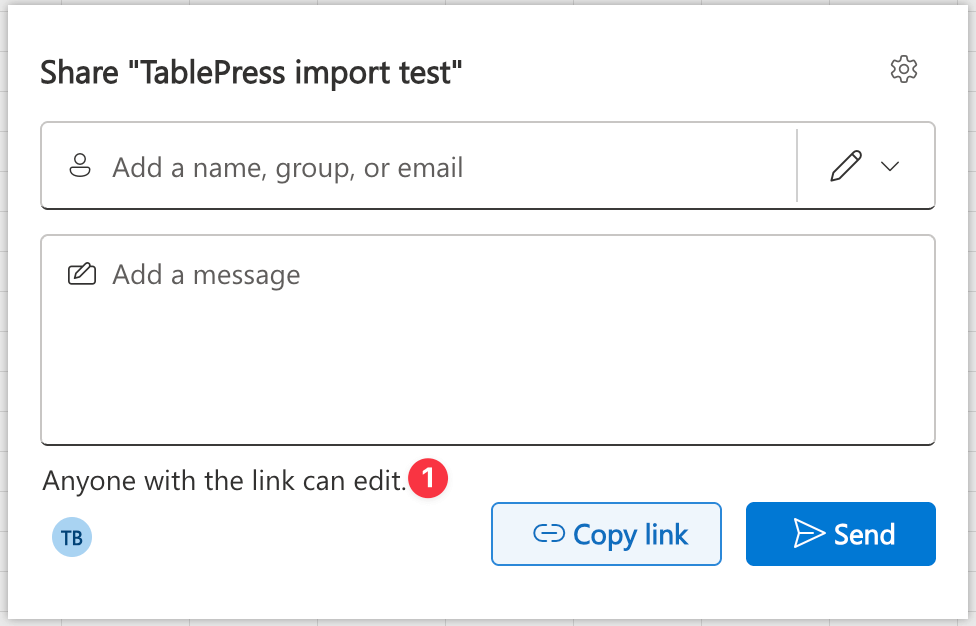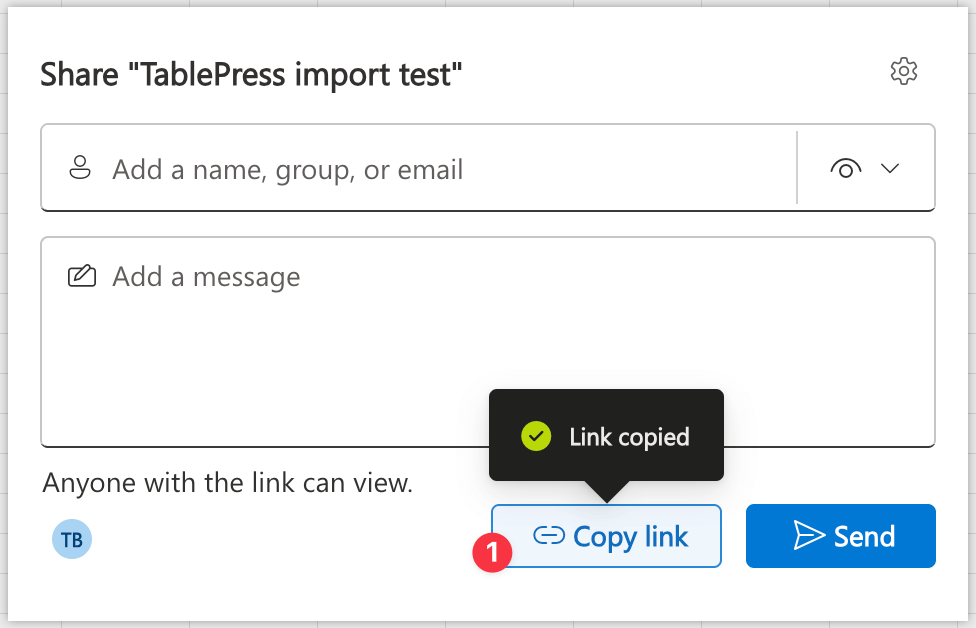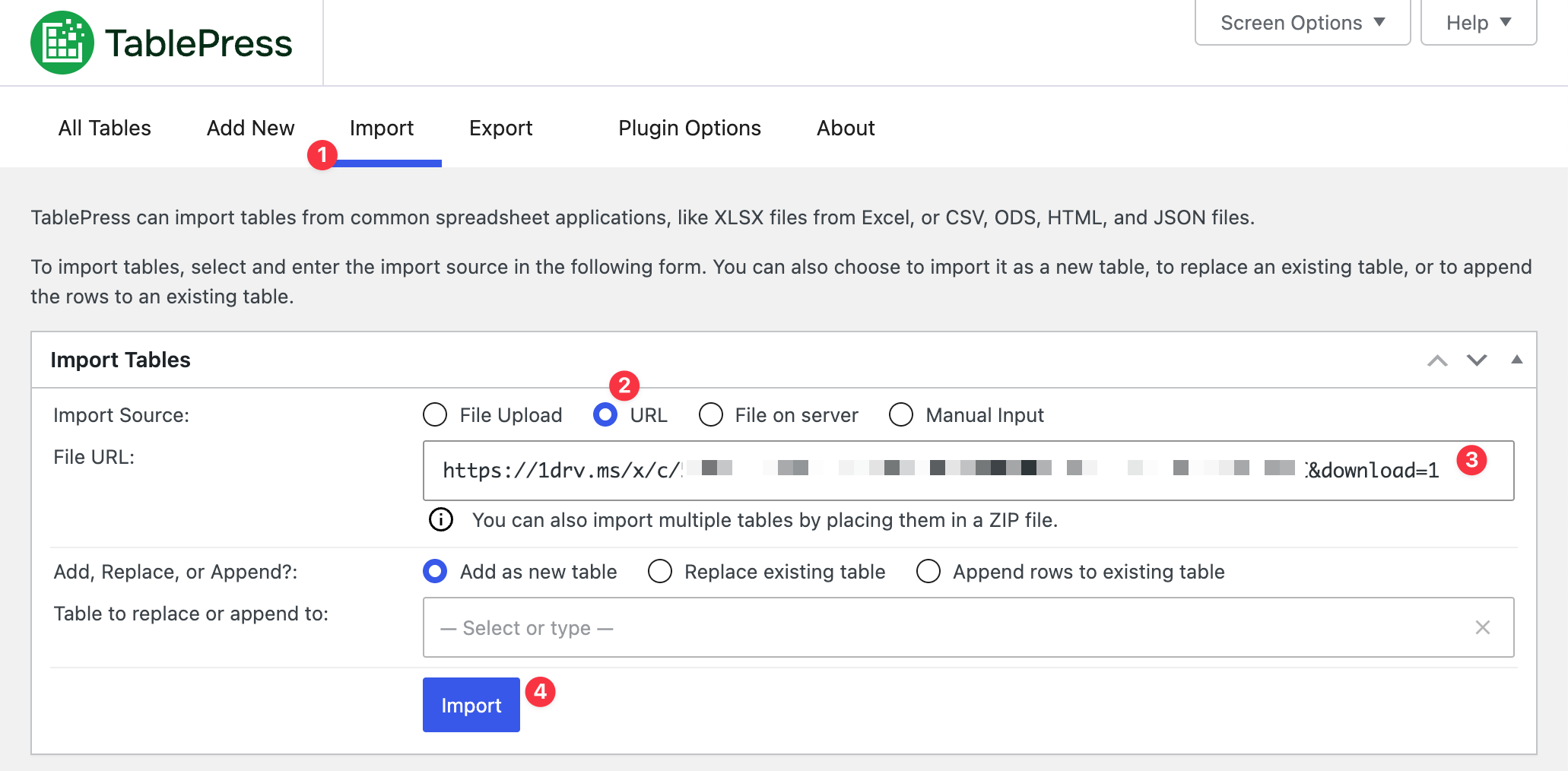Importing table data from external spreadsheet sources
How to import tables from Microsoft Excel Online (Office 365)
TablePress can import tables from a variety of popular spreadsheet applications. This includes XLSX files from Microsoft Excel, CSV (Character-Separated Values), ODS (OpenDocument Spreadsheet), HTML, and JSON files. In addition to uploading files from your local computer, it is also possible to import spreadsheets into your WordPress site by providing a URL (link address) to such a file.
This opens up the possibility to import a table from a Microsoft Excel Online (part of Office 365 and SharePoint) table into TablePress. (By the way: The TablePress Max license plan comes with the Automatic Periodic Table Import feature. This allows you to fully automate the table import process, saving you time and effort!)
All that you need for this is a link address to the spreadsheet that directly returns an appropriate file, without any user interface or login screen. This can be done by publicly sharing the Excel Online worksheet and then using a generated (secret) URL for the import into TablePress. Our beginner-friendly step-by-step tutorial will guide you through this process and show you how to find this URL for your Excel Online table.
Step 1: Open your Microsoft Excel Online Worksheet
Go to the Microsoft Office 365 website and sign in to your Microsoft account, if you are not yet logged in. If you are using a corporate version of Excel Online, e.g. via SharePoint, log into that. Create a new spreadsheet or open an existing one that contains the table you want to share.
Step 2: Share the Spreadsheet
Click the “File” menu (1) in the top-left corner of the navigation bar.

Choose “Share” (1), and click “Share with People” (2). Alternatively, click on the “Share” button in the top-right corner of the screen, if that’s shown.

In the “Share” dialog, click the “Anyone with the link can edit” text (1) right below the big text field.

In the “Sharing settings”, click “Can edit” (1) right below “More settings” and choose the “Can view / Can’t make changes” option (2). Then, click the “Apply” button (3).

Step 3: Obtaining the Sharing URL
After configuring the sharing settings, click the “Copy link” button (1) at the bottom of the dialog. You will see the black “Link copied” notification and will then have the shortened Sharing link for the Microsoft Excel Online user interface in your computer’s clipboard.

This Sharing link needs one small addition to be converted into the proper URL for downloading the table as a file. The link normally looks like
https://1drv.ms/x/c/{id}?e={authkey}Code language: HTML, XML (xml)where {id} and {authkey} are long sequences of letters and numbers that internally identify your worksheet. (If you are using Excel Online as part of a corporate Microsoft SharePoint instance, you will have a URL in the scheme
https://{company-id}.sharepoint.com/:x:/{some-long-id}?e={key}Code language: HTML, XML (xml)instead, but the procedure will be the same.)
To get the appropriate Sharing link for use with TablePress, simply append &download=1 to the end of this URL, like
https://1drv.ms/x/c/{id}?e={authkey}&download=1Code language: HTML, XML (xml)for the normal URL, or like
https://{company-id}.sharepoint.com/:x:/{some-long-id}?e={key}&download=1Code language: HTML, XML (xml)for the SharePoint version.
That’s it! You now have a link address that can be used for importing the Microsoft Excel Online table into TablePress!
A quick tip: To check if a URL link is suitable, try opening it in a “private”/”incognito” browsing window again. If you are offered an xlsx file for download, without seeing a spreadsheet user interface or having to log in first, the URL should work for the import into TablePress.
Step 4: Import the URL into TablePress
Once you have the correct Sharing URL from Step 3, you can use that for importing the Microsoft Excel Online worksheet into TablePress. For that, go to the “Edit” screen of TablePress on your WordPress site. Choose “URL” as the “Import Source” and paste the URL into the “File URL” text field. After clicking the “Import” button, your Excel Online table will be imported into TablePress. You can then edit it as needed and show it on your site by embedding the “TablePress table” block (if you are using the block editor) or the corresponding Shortcode into a post or page.

Note that (just like any other file import in TablePress) this is a one-time import. There is no automatic synchronization with changes in your Excel Online worksheet! However, there is a great solution for that as well: The TablePress Max license plan comes with the Automatic Periodic Table Import feature. This module can periodically import your tables periodically (e.g. every minute, every hour, etc.). Not only does this help you save a lot of time by not having to repeat the import task manually, but it also allows other people to update tables on your website, e.g. by using a shared Excel Online worksheet for data editing.
By the way: This process also works with files uploaded to Microsoft OneDrive! To open the Sharing dialog, just right-click on the file in OneDrive and find the “Share” entry. Then, follow the steps above.
Tutorials on how to create such a URL for other services like Google Sheets, Google Drive, or Dropbox are available on the Tutorials, Guides, and How-tos page.